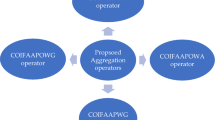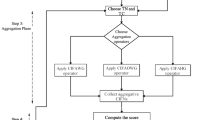Abstract
Trapezoidal Atanassov’s intuitionistic fuzzy numbers (TrAIFNs) is one of the useful tools to manage the fuzziness and vagueness in expressing decision data and solving decision making problems. In this paper, based on the operation laws defined by strict t-norms and t-conorms, four kinds of power geometric operators, i.e., triangular (co)norms-based (T-based) power geometric operator of TrAIFNs, T-based weighted power geometric operator of TrAIFNs, T-based power ordered weighted geometric operator of TrAIFNs, and T-based power hybrid geometric operator of TrAIFNs, are developed. To minimize loss of information in process, a new ranking method of TrAIFNs are presented based on the newly proposed possibility differences of TrAIFNs; Moreover, utilizing strict t-conorms, a new similarity measurement of TrAIFNs is innovated. Thereby, in combination with all the referred elements, two approaches to multiple attributes group decision making using TrAIFNs are developed. In the end, the feasibility of those methods and the superiority over the existing methods are demonstrated by a numerical example.


Similar content being viewed by others
References
Zadeh, L.A.: Fuzzy sets. Inf. Control 8, 338–356 (1965)
Xu, Z.S.: Intuitionistic Fuzzy Aggregation and Clustering. Studies in Fuzziness and Soft Computing, Springer, Berlin (2012)
Xu, Z.S., Liao, H.C.: A survey of approaches to decision making with intuitionistic fuzzy preference relations. Knowl.-Based Syst. 80, 131–142 (2015)
Atanassov, K., Gargov, G.: Interval valued intuitionistic fuzzy sets. Fuzzy Sets Syst. 31, 343–349 (1989)
Wan, S.P., Dong, J.Y.: Interval-valued intuitionistic fuzzy mathematical programming method for hybrid multi-criteria group decision making with interval-valued intuitionistic fuzzy truth degrees. Inf. Fusion 26, 49–65 (2015)
Li, D.F.: A ratio ranking method of triangular intuitionistic fuzzy numbers and its application to MADM problems. Comput. Math. Appl. 60, 1557–1570 (2010)
Shu, M.H., Cheng, C.H., Chang, J.R.: Using intuitionistic fuzzy sets for fault-tree analysis on printed circuit board assembly. Microelectron. Reliab. 46, 2139–2148 (2006)
Wang, J.Q., Nie, R.R., Zhang, H.Y., Chen, X.H.: New operators on triangular intuitionistic fuzzy numbers and their applications in system fault analysis. Inf. Sci. 251, 79–95 (2013)
Wan, S.P.: Power average operators of trapezoidal intuitionistic fuzzy numbers and application to multi-attribute group decision making. Appl. Math. Model. 37, 4112–4126 (2013)
Wan, S.P., Dong, J.Y.: Power geometric operators of trapezoidal intuitionistic fuzzy numbers and application to multi-attribute group decision making. Appl. Soft Comput. 29, 153–168 (2015)
Wei, G.W.: Some arithmetic aggregation operators with intuitionistic trapezoidal fuzzy numbers and their application to group decision making. J. Comput. 5, 345–351 (2010)
Wan, S.P.: Multi-attribute decision making method based on interval-valued intuitionistic trapezoidal fuzzy number. Control Decis. 25, 773–776 (2011)
Wei, G., Zhao, X., Wang, H.: An approach to multiple attribute group decision making with interval intuitionistic trapezoidal fuzzy information. Technol. Econ. Dev. Econ. 18, 317–330 (2012)
Wu, J., Liu, Y.J.: An approach for multiple attribute group decision making problems with interval-valued intuitionistic trapezoidal fuzzy numbers. Comput. Ind. Eng. 66, 311–324 (2013)
Li, D.F., Liu, J.C.: A parameterized non-linear programming approach to solve matrix games with payoffs of I-fuzzy numbers. IEEE Trans. Fuzzy Syst. 23, 885–896 (2015)
Garg, H.: A novel correlation coefficients between Pythagorean fuzzy sets and its applications to decision-making processes. Int. J. Intell. Syst. 31(12), 1234–1252 (2016)
Lang, G.M., Miao, D.Q., Fujita, H.: Three-way group conflict analysis based on Pythagorean fuzzy set theory. IEEE Trans. Fuzzy Syst. 28(3), 447–461 (2019)
Deveci, M., Pamucar, D., Gokasar, I., Koppen, M., Gupta, B.B.: Personal mobility in metaverse with autonomous vehicles using Q-rung orthopair fuzzy sets based OPA-RAFSI model. IEEE Trans. Intell. Transp. Syst. (2022). https://doi.org/10.1109/TITS.2022.3186294
Xiao, L.M., Huang, G.Q., Pedrycz, W., Pamucarc, D., Martineze, L., Zhang, G.B.: A Q-rung orthopair fuzzy decision-making model with new score function and best-worst method for manufacturer selection. Inf. Sci. 608, 153–177 (2022)
He, S.F., Wang, Y.M.: Evaluating new energy vehicles by picture fuzzy sets based on sentiment analysis from online reviews. Artif. Intell. Rev. (2022). https://doi.org/10.1007/s10462-022-10217-1
Xu, Z.S., Yager, R.R.: Some geometric aggregation operators based on intuitionistic fuzzy sets. Int. J. Gen Syst 35, 417–433 (2006)
Yager, R.R.: The power average operator. IEEE Trans. Syst. Man Cybern. Part A 31, 724–731 (2001)
Xu, Y.J., Merigo, J.M., Wang, H.M.: Linguistic power aggregation operators and their application to multiple attribute group decision making. Appl. Math. Model. 36, 5427–5444 (2012)
Wan, S.P., Yi, Z.H.: Power average of trapezoidal intuitionistic fuzzy numbers using strict t-norms and t-conorms. IEEE Trans. Fuzzy Syst. 24, 1035–1047 (2015)
Alsina, C., Frank, M.J., Schweizer, B.: Associative Functions: Triangular Norms and Copulas. World Scientific Publishing Co, Singapore (2006)
Klement, E.P., Mesiar, R., Pap, E.: Triangular Norms. Kluwer Academic Publishers, Dordrecht (2000)
Yi, Z.H., Li, H.Q.: Triangular norm-based cuts and possibility characteristics of triangular intuitionistic fuzzy numbers for decision making. Int. J. Intell. Syst. 33, 1165–1179 (2018)
Atanassov K., Tsvetkov R.: New intuitionistic fuzzy operations, operators and topological structures. Iran. J. Fuzzy. Syst. 20(7), 37–53 (2023)
Li, H.Q., Yi, Z.H., Fang, Y.: Portfolio selection under uncertainty by the ordered modular average operator. Fuzzy Optim. Decis. Mak. 18, 1–14 (2019)
Yi, Z.H., Li, H.Q.: Environmental, social and governance investing assessment under incomplete information by the power aggregation model on probabilistic linguistic terms. IEEE Access 9, 120442–120450 (2021)
Yao, L., Yi, Z.H.: A DEMATEL-based method for linguistic multiple attributes group decision making using strict t-norms and t-conorms. Systems 10, 98 (2022)
Barrenechea, E., Fernandez, J., Pagola, M., et al.: Construction of interval-valued fuzzy preference relations from ignorance functions and fuzzy preference relations. Appl. Decis. Mak. Knowl. Based Syst. 58, 33–44 (2014)
Bustince, H., Galar, M., Bedregal, B., Kolesarova, A., Mesiar, R.: A new approach to interval-valued Choquet integrals and the problem of ordering in interval-valued fuzzy set applications. IEEE Trans. Fuzzy Syst. 21, 1150–1162 (2013)
Bustince, H., Fernandez, J., Kolesarova, A., Mesiar, R.: Generation of linear orders for intervals by means of aggregation functions. Fuzzy Sets Syst. 220, 69–77 (2013)
Miguel, L.D., Bustince, H., Fernandez, J., Indurain, E., Kolesarova, A., Mesiar, R.: Construction of admissible linear orders for interval-valued Atanassov intuitionistic fuzzy sets with an application to decision making. Inf. Fusion 27, 189–197 (2016)
Zhang, G.Q., Dong, Y.C., Xu, Y.F.: Consistency and consensus measures for linguistic preference relations based on distribution assessments. Inf. Fusion 17, 46–55 (2014)
Baccour, L., Alimi, A.M., John, R.I.: Similarity measures for intuitionistic fuzzy sets: state of the art. J. Intell. Fuzzy Syst. 24, 37–49 (2013)
Beliakov, G., Pagola, M., Wilkin, T.: Vector valued similarity measures for Atanassov’s intuitionistic fuzzy sets. Inf. Sci. 280, 352–367 (2014)
Chen, S.M., Chang, C.H.: A novel similarity measure between Atanassov’s intuitionistic fuzzy sets based on transformation techniques with applications to pattern recognition. Inf. Sci. 291, 96–114 (2015)
Chen, S.M., Yeh, M.S., Hsiao, P.Y.: A comparison of similarity measures of fuzzy values. Fuzzy Sets Syst. 1, 79–89 (1995)
Chiclana, F., Tapia Garcia, J.M., del Moral, M.J., Herrera-Viedma, E.: A statistical comparative study of different similarity measures of consensus in group decision making. Inf. Sci. 221, 110–123 (2013)
Wang, X.Z., Baets, B.D., Kerre, E.E.: A comparative study of similarity measures. Fuzzy Sets Syst. 73, 259–268 (1995)
Li, D.F., Cheng, C.T.: New similarity measures of intuitionistic fuzzy sets and application to pattern recognitions. Pattern Recognit. Lett. 23, 221–225 (2002)
Bustince, H., Fernandez, J., Mesiar, R., Montero, J., Orduna, R.: Overlap functions. Nonlinear Anal. 72(3), 1488–1499 (2010)
G\(\acute{o}\)mez, D., Rodr\(\acute{i}\)guez, J.T., Montero, J., Bustince, H., Barrenechea, E.: n-Dimensional overlap functions. Fuzzy Sets Syst. 287, 57–75 (2016)
Dimuroa, G.P., Bedregal, B., Bustince, H., Asiainc, M.J., Mesiard, R.: On additive generators of overlap functions. Fuzzy Sets Syst. 287, 76–96 (2015)
Xu, Z.S., Yager, R.R.: Power geometric operators and their use in group decision making. IEEE Trans. Fuzzy Syst. 18, 94–105 (2010)
Yager, R.R.: On ordered weighted averaging aggregation operators in multi-criteria decision making. IEEE Trans. Syst. Man Cybern. 18, 183–190 (1988)
Xu, Z.S., Da, Q.: An overview of operators for aggregating information. Int. J. Intell. Syst. 18, 953–969 (2003)
Liao, H., Xu, Z.: Intuitionistic fuzzy hybrid weighted aggregation operators. Int. J. Intell. Syst. 29, 971–993 (2014)
Xia, M.M., Xu, Z.S., Zhu, B.: Some issues on intuitionistic fuzzy aggregation operators based on Archimedean t-conorm and t-norm. Knowl.-Based Syst. 31, 78–88 (2012)
Chen, Z.S., Yang, L.L., Rodriguez, R.M., Xiong, S.H., Chin, K.S., Martinez, L.: Power-average-operator-based hybrid multiattribute online product recommendation model for consumer decision-making. Int. J. Intell. Syst. 36, 2572–2617 (2021)
Liao, H.C., Mi, X., Xu, Z.S.: A survey of decision-making methods with probabilistic linguistic information: bibliometrics, preliminaries, methodologies, applications and future directions. Fuzzy Optim. Decis. Mak. 19(1), 81–134 (2020)
Yi, Z.H.: Decision-making based on probabilistic linguistic term sets without loss of information. Complex Intell. Syst. 8, 2435–2449 (2022)
Acknowledgements
Zhihong Yi is very grateful to Prof. Shuping Wan (Jiangxi University of Finance and Economics) for his valuable suggestions on the preparation of the manuscript, and Prof. Feng Qin (Jiangxi Normal University) and Prof. Hongquan Li for their directions. This work is supported by PhD Research Startup Foundation of Nanchang Normal University under Grant NSBSJJ2020015, Jiangxi Natural Science Foundation (No. 20224BAB201015), and the Scientific Research Foundation of Jiangxi Provincial Education Department (No. GJJ2202014), and National Natural Science Foundation of China(No.12261049).
Author information
Authors and Affiliations
Corresponding author
Additional information
Publisher's Note
Springer Nature remains neutral with regard to jurisdictional claims in published maps and institutional affiliations.
Rights and permissions
Springer Nature or its licensor (e.g. a society or other partner) holds exclusive rights to this article under a publishing agreement with the author(s) or other rightsholder(s); author self-archiving of the accepted manuscript version of this article is solely governed by the terms of such publishing agreement and applicable law.
About this article
Cite this article
Yi, Z., Yao, L. & Garg, H. Power Geometric Operations of Trapezoidal Atanassov’s Intuitionistic Fuzzy Numbers Based on Strict t-Norms and t-Conorms and Its Application to Multiple Attribute Group Decision Making. Int. J. Fuzzy Syst. 26, 239–259 (2024). https://doi.org/10.1007/s40815-023-01591-1
Received:
Revised:
Accepted:
Published:
Issue Date:
DOI: https://doi.org/10.1007/s40815-023-01591-1




